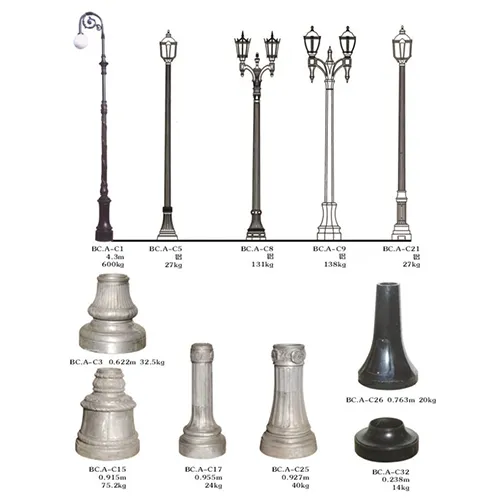Light poles, also known as street lights, street lamps, or lamp posts, are an integral part of urban and suburban infrastructure, providing illumination for pedestrians, cyclists, and motorists during nighttime or low-light conditions. The materials used in the construction of light poles are chosen based on factors such as strength, durability, weight, maintenance, cost, and aesthetic appeal. Here's an original article discussing the common materials used for light poles:

Illuminating the Night: A Guide to the Materials of Light Poles
When the sun sets and the city's lights flicker on, light poles take center stage in the urban landscape. These silent sentinels of the night are not only functional but also an element of design. The materials from which they are made play a crucial role in their performance and longevity. Let's shed some light on the primary materials used in the construction of light poles.
Steel: The Backbone of Urban Lighting
Steel is a stalwart in the realm of light poles. Known for its strength and resilience, steel poles can withstand significant loads and resist the forces of nature. Galvanized steel, which is steel coated with a layer of zinc, offers enhanced protection against corrosion. This makes it an ideal choice for outdoor use where the poles are exposed to rain, snow, and harsh environmental conditions. Steel poles can be easily fabricated into various shapes and sizes, providing versatility for custom designs.
Aluminum: The Featherweight Champion
Aluminum light poles are the go-to option when weight is a concern. These poles are lightweight, making them easier and less expensive to transport and install. Despite their lower mass, aluminum poles offer considerable strength and are naturally resistant to corrosion, which means they require less maintenance over time. Their sleek, modern appearance is favored in contemporary urban designs.
Fiberglass: The Stealthy Innovator
Fiberglass, or glass-reinforced plastic (GRP), is a composite material that has been gaining popularity in the light pole industry. This material offers an excellent strength-to-weight ratio and can be molded into various shapes and textures. Fiberglass poles are impervious to corrosion, and their non-conductive properties make them a safe choice in areas prone to electrical hazards. The versatility of fiberglass allows for creative designs that can mimic the look of more traditional materials like wood or stone.
Concrete: The Solid Performer
Concrete poles are a testament to endurance. These poles are incredibly durable and provide substantial support for heavy lighting fixtures and other equipment. Concrete's high density makes it resistant to vandalism and provides a stable base that is less likely to sway in strong winds. While concrete poles are more challenging to install due to their weight, their longevity and low maintenance requirements make them a cost-effective choice for many municipalities.
Wood: The Natural Classic
Wooden light poles, often made from treated lumber such as pine or cedar, bring a touch of natural beauty to their surroundings. They blend seamlessly into parks and rural settings. While not as prevalent in modern urban environments, wooden poles are valued for their classic look and environmental friendliness. However, they do require regular maintenance to prevent decay and are not as durable as their metal or concrete counterparts.
The Future of Light Pole Materials
As technology advances, new materials and manufacturing processes continue to emerge. Innovations such as carbon fiber and advanced plastics are beginning to make their way into the light pole market, offering even greater strength and durability with reduced weight. The integration of smart technology into light poles is also influencing material choice, as connectivity and sensor compatibility become essential features.
What is introduced to you above is "What materials are light poles made of". The choice of material for light poles is a balance of functionality, aesthetics, and economics. Whether it's the robustness of steel, the lightness of aluminum, the versatility of fiberglass, the solidity of concrete, or the natural charm of wood, each material brings its unique advantages to the table. As cities evolve, so too will the materials we use to light our way through the night.